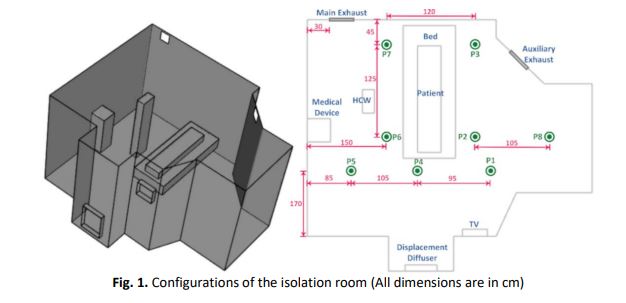Numerical Investigation of Covid-19 Infection Spread Expelled from Cough in an Isolation Ward Under Different Air Distribution Strategies
DOI:
https://doi.org/10.37934/arfmts.95.1.1735Keywords:
COVID-19, isolation room, UFAD, particles, air quality, coughAbstract
COVID-19 is a severe and rapidly spreading respiratory disease that can be transmitted through airborne particles, emitted from cough. This study investigated the influence of underfloor air distribution (UFAD) and overhead air distribution on the diffusion of the coughed particles emitted from two infected patients in an isolation ward. Additionally, the study examined the performance of mounting retractable covers around the exhausts on minimizing the dispersion of the particles. A coupled Eulerian-Lagrangian approach is adopted by using a discrete random walk model. The effect of Brownian force, drag force with Cunningham slip correction factor, turbulence dispersion, Rosin-Rammler, and the breakup is considered in the respiratory airborne coughed particles simulation. The model has a good agreement with the experimental data. The results show that overhead air distribution (case 1) disperses the particles faster to the occupied zone due to the strong mixing between downward inlet airflow and indoor air accompanied by infectious particles. The usage of retractable covers (case 2) significantly minimized the diffusion of the particles inside the ward and their residence time. The particles quantity drops by 53, 98.62, and 99.94 % at 2.0, 10.0, and 120.0 s, respectively, compared to case 1. Case 2 shows the best efficient protection and inhaled air quality for the HCW in all the walking areas inside the room. The upward inlet air in underfloor air distribution (case 3) keeps particles floating for a while at a higher level near the ceiling exhausts, enhancing removal efficiency. Also, it has a slower lateral dispersion of the particles than in case 1. Underfloor air distribution minimized the number of particles by 30.0 % at 120.0 s, compared to overhead air distribution. Inlet air location significantly affects the diffusion of infectious particles in the indoor environment.
Downloads
































